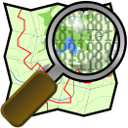
OpenStreetMap is a free street level map of the world, created by an ever growing community of mappers. Anyone can edit OpenStreetMap. The Learn OSM website provides easy to understand, step-by-step guides for you to get started with contributing to OpenStreetMap and using OpenStreetMap and using OpenStreetMap data. The Learn OSM guide at the link above shows step by step how to navigate the OpenStreetMap website, view and print maps, and sign up for a user account. After you have your own username and password, you will be able to add your first points to the map, learn how to do street surveys and work with aerial imagery.
The remainder of this quickstart introduces some of the off-line software used to edit and render OSM data.
JOSM (Java OpenStreetMap Editor) is an editor for OpenStreetMap (OSM) written in Java. The current version supports stand alone GPX tracks, GPX track data from OSM database and existing nodes, line segments and metadata tags from the OSM database.
The JOSM plugin collection contains the following plugins:
Merkaartor is a map editor for OpenStreetMap which uses the Qt toolkit. It’s a bit more user friendly than JOSM, but has a few less features.
Osmosis is a highly capable utility program for performing many tasks at a raw level on OSM data. This includes data import and export to databases, sorting, cleaning, and creating data dumps. See the detailed usage page for more information. A simple report of author contributions can be performed as follows. Open a new Terminal, and at a command prompt type the following:
osmosis --read-xml ~/data/osm/feature_city.osm.bz2 --report-entity
Then look in the new entity-report.txt file in the home directory for the report details.
osm2pgsql is a utility program that converts OpenStreetMap (.osm) data into a format that can be loaded into PostgreSQL (PostGIS). It is often used to render OSM data visually using Mapnik, as Mapnik can query PostgreSQL for map data, but does not work directly with OSM files.